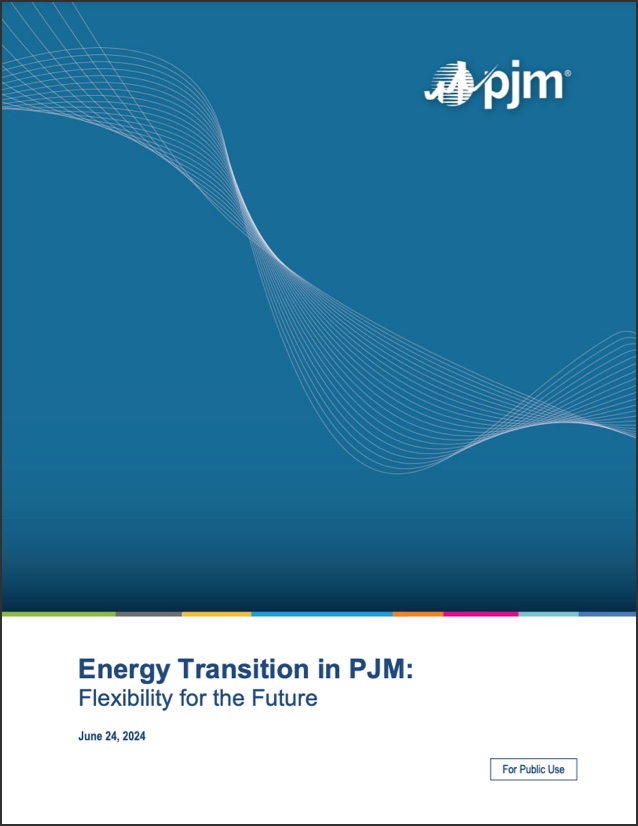Reform & Strengthen

Enhancing Transmission To Meet New, Changing Demand
PJM forecasts demand growth up to 40% over the next 15 years, expanding transmission system need for more than 67 million people across 13 states and Washington, D.C.
In February 2025, the PJM Board approved a collection of solutions recommended to solve reliability needs identified in Window 1 of the 2024 Regional Transmission Expansion Plan (RTEP) (PDF). These projects address accelerated load growth in various areas of the PJM region, changes in the mix of generation resources and the resulting shifts to regional power flows. The forecasted demand growth is driven in part by data center load additions and the electrification of vehicles and building heating systems. The proposals resolve critical west-east regional transfer reinforcement needs by introducing 765 kV transmission lines connecting the American Electric Power (AEP) system in the western portion of the PJM footprint with the rest of the network in the central and southern parts of PJM, primarily Virginia. The work also includes several regional projects that are driven by more local needs.

Load Forecasts Guide the Grid
PJM Planning incorporated a long-term load forecast projecting annual demand growth of 2% for summer peaks and 2.4% for winter peaks for the next 20 years.
PJM RTO Summer Peak Demand Forecast
These numbers indicate:
Forecasted peak energy demand growth of 42,000 MW in summer and 43,000 MW in winter by 2039
Demand growth primarily driven by development of energy-intensive data centers and electrification of vehicles and building heating systems
To improve the load forecast, PJM implemented a standardized template for the yearly requests for large load adjustments from electric distribution companies to help filter out speculative projects or double counting.
More Transmission Solutions Sought for Growing Need
In July, PJM opened another window, 2024 RTEP Window 1, to solicit solutions to reliability concerns driven by accelerated load growth as well as changing regional power flows and generation. This window focused on strengthening transmission paths between PJM’s western and eastern regions while also solving local transmission issues. In response, 94 proposals were submitted by 16 entities. Six additional proposals were submitted as joint portfolios, grouping individual proposals. These addressed critical west-east regional transfer reinforcement needs with 765 kV transmission to connect AEP’s system in the west with the network in central and southern PJM. In all, the Window 1 cost was estimated at $5.8 billion.
94
proposals were submitted by
16
entities
6
additional proposals were submitted as joint portfolios, grouping individual proposals
The Window 1 cost
was estimated at
$5.8
Billion
Partnership for Interregional Transfer Capability
PJM’s ability to rely on and support neighboring grids requires increased coordination. As a result, PJM and MISO embarked on a collaborative, informational interregional transfer capability study.
PJM and MISO are exploring opportunities to:
Engage in joint transmission analysis and coordinated modeling.
Leverage planning processes to promote reliability and resilience through holistic, efficient and cost-effective transmission planning.
FERC Order 1920 on Long-Term Planning
Having worked with stakeholders on long-term planning since 2022, PJM changed course to begin developing specific future scenarios for long-term transmission planning as the first priority in response to FERC’s new Order 1920. The order also mandates more state participation and enhanced local planning transparency.
FERC Order 1920 requires that transmission providers:
- 1Engage in regional long-term transmission planning to identify transmission needs with a minimum 20-year planning horizon.
- 2Develop a process for selecting transmission facilities to resolve those needs.
- 3Devise cost-allocation methods based on forecasted costs of the facilities.
- 4Develop at least three long-term scenarios that utilize enumerated factor categories.
- 5Update long-term scenarios at least once every five years.

'We Need Capacity'
PJM President and CEO Manu Asthana voiced his concern on the subject at the annual meeting of the Organization of PJM States, saying, “We need capacity – a lot of capacity.”
To that end, PJM and stakeholders improved the process by which new generation gets connected to the grid, with the new process demonstrating tangible results. In 2024:
Fast Lane Projects:
PJM completed studies for all Fast Lane projects with over
17 GW
advancing through the Generation Interconnection Agreement and required security. These projects are now cleared for engineering, procurement and construction activities. PJM currently has over
46 GW
authorized for these activities.
Transition Cycle 1 (TC1):
PJM completed TC1 Phase 1 and Phase 2. Currently,
132 projects
representing approximately 20 GW are under review. PJM anticipates issuing Final Agreements for these projects by Q4 2025.
Transition Cycle 2 (TC2):
The application window for TC2 closed with approximately
550 project applications
submitted, representing over 54 GW of generation. PJM expects TC2 Phase 1 to be completed by the end of September 2025.
Flexibility for the Future
Adequate generation continued to be a theme explored in PJM’s ongoing planning for the changing fuel mix.
In June, PJM published its fourth installment in a series, Energy Transition in PJM: Flexibility for the Future (PDF), that focused on the longer-term effects of the grid’s transition to examine challenges that may arise if current state and federal energy policy goals are met or accelerated.
The research built on the premise of prior studies: As demand growth and thermal generation retirements both accelerate and the pace of development of new resources continues to lag, the PJM region may experience a supply shortfall by 2030.
In the near term, the pace of development of resources to replace thermal retirements while maintaining reliability must continue to be a focus, the paper concluded. In the future, the complexity of system operations, markets and planning will only increase amid a largely intermittent and inverter-based generation fleet.
PJM Board Sounds Warning
PJM Board of Managers Chair Mark Takahashi sounded a warning in a Dec. 9 letter from the Board (PDF) explaining why it was instructing PJM to submit several Section 205 filings to FERC aimed at supporting resource adequacy.
Taking the anticipated 2025 load forecast into account, the PJM system could see a capacity shortage as soon as the 2026/2027 Delivery Year.
"To mitigate the risk of such an outcome, the Board supports the efforts outlined here that are intended to:
- Bring capacity online more expeditiously through the interconnection queue.
- Make sure price signals accurately reflect current supply-demand fundamentals."
He went on to say, “We do not expect that these filings, taken in aggregate, will fully resolve the resource adequacy challenge that we are facing, but we believe we must take the entire suite of actions to address the immediate reliability need.”
Supporting Resource Adequacy
PJM and stakeholders collaborated efficiently to strengthen the grid through many proposals to FERC in 2024:
Reliability Resource Initiative
The new Reliability Resource Initiative (PDF) is a one-time proposal to expedite the interconnection of a limited number of generating resources that are not presently in the queue to assist with resource adequacy concerns.
It reflects the growing urgency to connect generating resources that have a high likelihood of being able to materially support resource adequacy and maintain grid reliability in the near term.
The filing (PDF), approved in February 2025, adds up to 50 projects for study to TC2.
Surplus Interconnection Service
To get more generation faster, PJM proposed rule changes for Surplus Interconnection Service (PDF).
Surplus Interconnection Service refers to the unused portion of service for a facility that cannot or does not operate continuously every hour of every day year-round. It improves the ability to use these limited resources. The filing (PDF), approved in February 2025, enables an expedited process that allows new generation resources to use interconnection service.
Capacity Interconnection Rights
PJM Members endorsed a plan to enable retiring generators to more efficiently transfer their grid connection to new resources in the same area as a way to get much-needed replacement generation up and running faster.
If approved, the Capacity Interconnection Rights proposal (PDF) would operate outside of the existing interconnection process, be available to all technology resources and take about 10 months.
